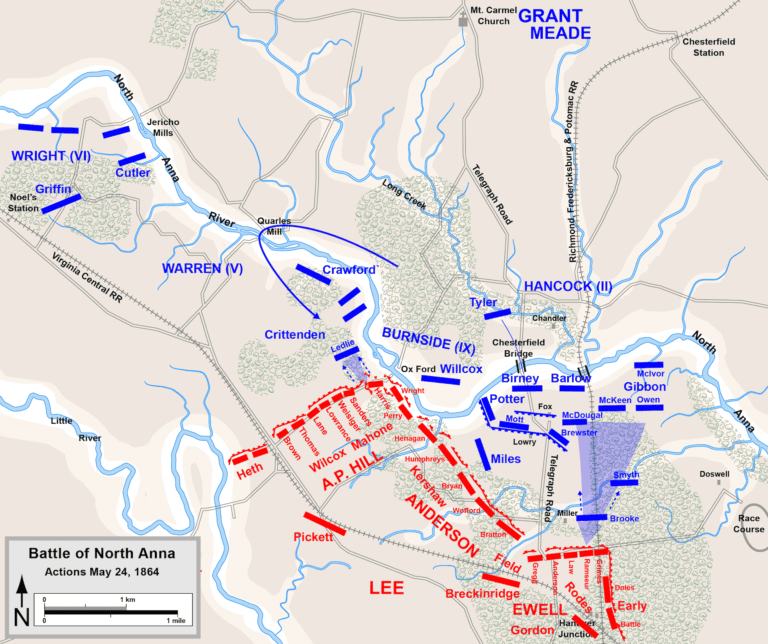The Battle of North Anna, which transpired on May 23-24, 1864, marked the third encounter of General Ulysses S. Grant’s Overland Campaign. It represented one of Robert E. Lee’s final major opportunities to land a significant strike against the Army of the Potomac.
The North Anna battlefield, nestled in Caroline and Hanover County, Virginia, is presently preserved by the Richmond National Battlefield Park, the American Battlefield Trust, and Hanover County Parks. The most notable sites include Lee’s Inverted V earthwork defense and Mount Carmel Church, which served as General Ulysses S. Grant’s headquarters.
The Battle of North Anna is one of the lesser-known conflicts of the American Civil War and the third encounter of General Grant’s Overland Campaign. Following a two-week impasse at Spotsylvania Court House, General Grant commenced a southward withdrawal on May 21, 1864, aiming to lure General Lee into the open.
General Lee prevailed in the race to the next natural defensive barrier to the south, settling on the southern bank of the North Anna River.
At this point, both armies were totally exhausted from constant marching and fighting since May 5, 1864. Gen. Grant’s war of attrition began to take a serious toll on Gen. Lee’s health who will be ill and must ride in the back of the carriage.
After serious Union casualties at Spotsylvania Court House and the last major Confederate reinforcements from Richmond to arrive just prior to battle, both armies will be the most evenly matched they will ever be with 67,000 Union versus 53,000 Confederates. This will prove to be one of Gen. Lee’s last great opportunities to strike a blow against the Union Army.
As General Lee relished a glass of buttermilk on the porch of the Fox House, the resonating sound of artillery heralded the arrival of General Grant, inaugurating the third battle of the Overland Campaign. General Grant sought to cross the North Anna River and strike the rebels at two different points.
On May 23, 1864, General Grant’s left wing, led by General Winfield Scott Hancock, seized Henagan’s Redoubt and secured the Chesterfield Bridge along the vital Telegraph Road, holding their positions as darkness fell.
Concurrently, General Grant’s right wing under General Gouverneur K. Warren undertook a tense crossing at Jericho Mills. An audacious attack by one of A.P. Hill’s Confederate Divisions initially sent the Federals into disarray. However, the timely arrival and deployment of U.S. artillery repelled the charging rebels before they could drive the Federals back into the river.
That evening, General Lee’s Chief Engineer Martin Luther Smith, the architect of the Vicksburg defenses, devised an innovative strategy to ensnare the Federals. He planned to create a series of earthworks in an inverted-v shape by harnessing the natural geography and a series of commanding ridges.
The structure of the inverted-v was designed to split the Union army, allowing a segment of Lee’s forces to spring the trap and destroy a Union Corps before reinforcements could arrive.
On May 24, 1864, as the Federals engaged with the rebels in their fortified earthworks, an ailing General Lee, confined to his tent, was heard to exclaim, “We must strike them a blow, we must strike them a blow!”
Despite the potential, the opportunity to spring the trap slipped through the rebels’ fingers as General Grant discerned General Lee’s plans and safely withdrew his forces. With no competent rebel commander available to spring the trap, General Lee’s indispensable role in the Confederacy was underscored.
A subsequent entrenchment resulted in another stalemate, prompting General Grant to once again withdraw and move southeast. He used the Pamunkey River as a shield for his army as they drew nearer to the gates of Richmond.
The stalemate resulted in a total of 2,600 Union casualties while the Confederates suffered 1,600 casualties.

Ready to explore the battlefield for yourself? Browse our full selection of American Civil War Battlefield Tours.
Please contact us if you have any questions about our tours or services.